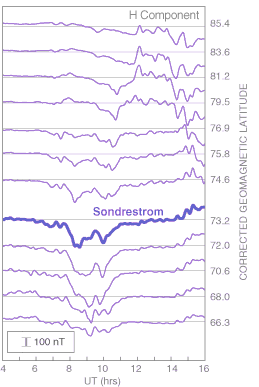|
This vector magnetometer is part of an array with 17 stations in Greenland. Previously operated by the Danish Meteorological Institute, it has been operated by DTU Space since 2009. Sondrestrom is an important node of this array, which records the magnetic field associated with ionospheric electric currents.
The ground-based three-axis flux-gate magnetometers are sensitive to variations of the ionospheric electric current (and to induced ground currents, of course). The west coast stations are used to determine the ionospheric Hall current across the chain. They are further used to identify and track disturbances of the current system, both in space and time. This includes large-scale intensifications and/or displacement of the electrojet as well as variations on a smaller temporal and spatial scale, such as ULF fluctuations (Alfven waves), and propagating transient events such as magnetic impulse events.
 A typical application would be to examine a set of coincident space-based and ground-based data to investigate ionospheric electric current closure and map out the footpoints of magnetospheric regions. The ionospheric current (or its equivalent, the convection) pattern bears the signature of the boundary between open and closed field lines which occurs quite often above Sondrestrom. Magnetic field enhancements and depressions (magnetic impulse events) are often signatures of interplanetary shocks hitting the magnetosphere, and short-scale fluctuations can reveal information about waves and instabilities. A typical application would be to examine a set of coincident space-based and ground-based data to investigate ionospheric electric current closure and map out the footpoints of magnetospheric regions. The ionospheric current (or its equivalent, the convection) pattern bears the signature of the boundary between open and closed field lines which occurs quite often above Sondrestrom. Magnetic field enhancements and depressions (magnetic impulse events) are often signatures of interplanetary shocks hitting the magnetosphere, and short-scale fluctuations can reveal information about waves and instabilities.
|


Jürgen Matzka
DTU Space
Technical University of Denmark
jrgm@space.dtu.dk
www.space.dtu.dk/English |



